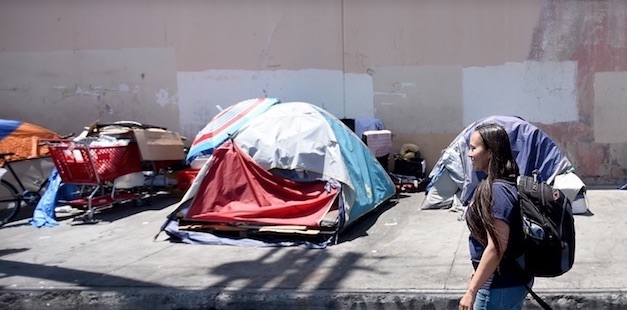Despite city and county housing initiatives, influx of people becoming homeless has stunted progress
Homelessness in Los Angeles has been a Sisyphean issue for the last several years, and despite keen efforts from lawmakers, a new staggering report on the homeless county shows unyielding immovability.
The Los Angeles Homeless Services Authority (LAHSA) released a report on Tuesday, June 4 that found a 16% citywide increase in homelessness (36,300 people) and a 12% increase across LA County (59,000 people), a stunning discovery given the city, county and state’s costly efforts to mitigate the problem within the last few years.
Over the last decade, tent encampments have percolated throughout the city, moving further and further away from Skid Row, which still has the highest concentration of the city’s homeless population as well as the center of services for the homeless.
One of the county’s most ardent efforts to quell the homeless numbers came in the form of Measure H, a sales tax that raises $355 million annually for homelessness services. Prop HHH, a $1.2 citywide supportive housing program, is designed to move more homeless folks into permanent supportive housing as well as those at risk for homelessness.
Last month, as reported by the Asian Journal, California Governor Gavin Newsom unveiled a $1 billion effort to solve the state’s overall homelessness problem, paying close attention to counties like Los Angeles, Kern and Orange that have the highest homeless concentrations.
And there a particular bright spot to the LAHSA report: more than 21,600 people have been moved into permanent housing due to a more robust city and county homeless crisis response system.
But why has the overall number of homeless people increased?
Michael Nailat, a program officer at the United Way-Greater Los Angeles, acknowledged the progress made in getting people currently living on the streets, but noted that more efforts need to be made in suppressing poverty and making sure more people aren’t becoming homeless.
“It’s not just about building more supportive and affordable housing, which is very important, but there are people who are on the margins at risk at becoming homeless, and if we can find a way to support them and keep them from losing their housing in the first place that would go a long way,” Nailat, whose work primarily focuses on data and projections regarding the homeless situation, told the Asian Journal. “We can help the people who are currently on the streets, but if there are people are becoming homeless every day it’s going to be that much harder to catch up.”
Income inequality and economic hardships that Angelenos face every day make just anyone susceptible to resorting to homelessness, Nailat said. Unexpected crises, mounting debt or accidents could veer anyone’s financial situation to the point of poverty, which is an issue Nailat believes that should be top of mind for every community.
According to the LAHSA survey, the homeless population is disproportionately black and Latino, and organizations such as United Way have begun looking into the larger picture of inequality.
“Those who are the most marginalized in our community are the most vulnerable,” Nailat said.
But that doesn’t necessarily mean that other communities, such as the Filipino community or the Asian community at large, shouldn’t worry about the homeless crisis, which, in essence, is an issue about economic instability.
“Filipinos, especially those in the economic margins, gotta be thinking about, ‘Do I have a good support system?’ or ‘Do I have the resources to survive a crisis?’ It could be anything but for our ability to deal with these crises we could be the next community on this street,” Nailat, who is Filipino American, said.
He pointed out that an increasing number of older Filipinos living under the poverty line are also being evicted.
“Filipinos, by and large, have among the highest rates of debts, like mortgage debt, credit card debt and all these things, so we’re in this precarious position, too, as Filipinos because if we don’t think in the longer term — just because some of us have a job, good income and a nice place to live — the question we should ask ourselves is if I had to pay something that costs $1,000 or $2,000 and I had no way around it would I have enough money to take care of that sudden emergency,” Nailat said.
When in a crisis, Filipinos usually have a family safety net to turn to, and the very nature of the Filipino American community is one of a familial bond. If things turn south, there’s always that option to go back home to the Philippines, but for younger and future generations that call the United States their de facto home, that option doesn’t exist.
“As our Filipino American community becomes more integrated into this country, but 2nd, 3rd, 4th generation of Filipinos might not have the same set of options as anyone else, and if faced with a crisis, who are you going to turn to if you don’t have the same family and cultural ties? We have to start thinking about these things and having conversations around these because our community isn’t safe from this issue,” Nailat said.
Despite the staggering numbers, Nailat thinks that the homeless and housing situation is moving in the right direction as long as the county and city receive support from the state. Measures like Prop HHH, he said, could double the supportive housing units within the next five to seven years, he said.
“We’re also focusing on really educating people on the benefits of these things — supportive and affordable housing — to our community and why they’re important to all our communities,” Nailat said. “An increase [in the homeless population] isn’t good by any means, and it is disappointing to see another year in which we saw an increase, but the county has done fairly well compared to the rest of the state.” (Klarize Medenilla/AJPress)






